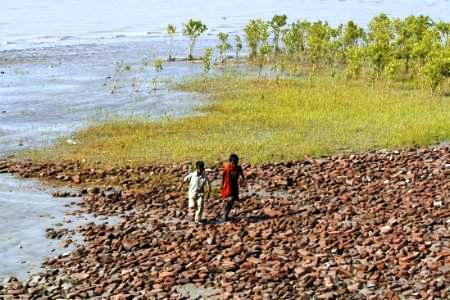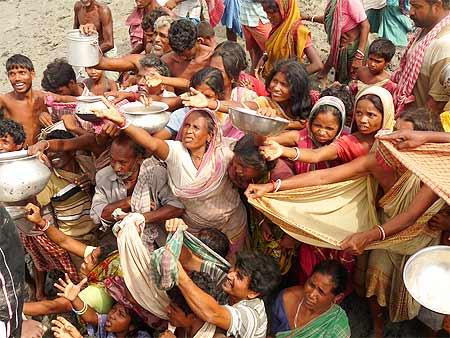Photographs: Jayanta Shaw/Reuters
Industries located along the Gangetic delta in Haldia, Kolkata and its outskirts are polluting the fragile ecosystem of Sundarbans, home to 40 lakh (4 million) people and the Royal Bengal Tiger, a latest study says.
The research, conducted by a group of scientists from Calcutta University and Techno India University, says there has been a steady increase in the percentage of toxic heavy metals leading to the gradual deterioration of water there.
The scientists studied presence of zinc, copper and lead in the body of a shellfish species, commonly known as the Indian white shrimp, to assess the damage being done to the aqua-system.
. . .
How industrial waste is polluting Sundarbans' ecosystem
Image: A woman works in a paddy field at Mathurakhand village in Sunderbans.Photographs: Parth Sanyal/Reuters
Found abundantly in the water of Sundarbans, which has the largest mangrove forest in the world, Indian white shrimp is commercially important too.
"The low salinity and intense industrialisation in the Hooghly estuarine stretch is responsible for the high concentration of heavy metals in the shrimp muscle sampled from stations in and around the western side of Sundarbans," lead researcher and marine scientist, Dr Abhijit Mitra said.
In the study, heavy metals in the white shrimp's muscle exhibit a more or less similar order as that in water.
. . .
How industrial waste is polluting Sundarbans' ecosystem
Image: Fishermen at the Sunderbans.Photographs: Reuters
Interlinked by a complex network of tidal waterways and dotted with small islands of salt-tolerant mangrove forests, this biodiversity-rich world heritage site is famous as the last surviving coastal habitat of the Royal Bengal Tiger.
Though heavy metals such as copper, zinc and lead are normal constituents of marine and estuarine environments, additional quantities when introduced through industrial wastes or sewage enter the biogeochemical cycle and pose negative impact on the biotic community.
. . .
How industrial waste is polluting Sunderbans' ecosystem
Image: Children play on a damage embankment behind mangrove plantations at Moushuni island, Sunderbans.Photographs: Jayanta Shaw/Reuters
"Due to the toxic nature of certain heavy metals, these chemical constituents interfere with the ecology of the environment and on entering into the food chain they cause potential health hazards, mainly to human beings," says co-researcher Subhra Bikash Bhattacharyya from Techno India.
The highest concentration of heavy metals in prawn muscle was found at Nayachar island, near the Haldia industrial belt.
The lowest concentration was observed at Satjelia island, far away from the industrial and anthropogenic stresses, in the Matla estuarine stretch and almost adjacent to the protected reserve mangrove forest.
. . .
How industrial waste is polluting Sundarbans' ecosystem
Image: This file photo shows aila victims reaching out for food and water as a relief boat reaches Bijoynagar in Gosaba.Photographs: Dipak Chakraborty/rediff.com
Rapid industrialisation and urbanisation in Kolkata, Howrah and the newly emerging Haldia complex have caused considerable ecological imbalance in the adjacent coastal zone.
The chain of factories and industries situated on the western bank of the Hooghly estuary is a major cause behind the gradual transformation of this beautiful ecozone into stinking cesspools, ecologists say.
The lower part of the estuary has various industries like paper, textiles, chemicals, pharmaceuticals, plastic, shellac, food, leather, jute, tyres and cycle rims.
These units are point sources of heavy metals in the estuarine water, the report says.






article